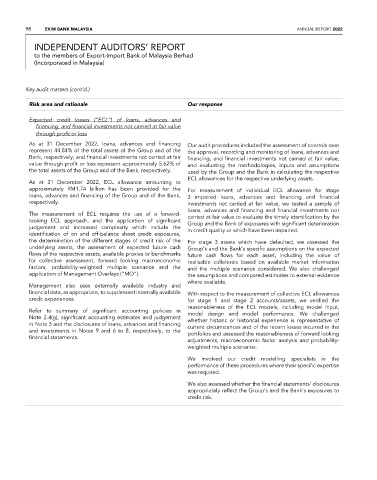Page 100 - EXIM-Bank_Annual-Report-2022
P. 100
98 eXIM BANK MALAYsIA ANNUAL REPORT 2022
InDEPEnDEnT auDITORS’ REPORT
to the members of Export-Import Bank of malaysia Berhad
(Incorporated in malaysia)
Key audit matters (cont’d.)
Risk area and rationale Our response
Expected credit losses (“ECL”) of loans, advances and
financing, and financial investments not carried at fair value
through profit or loss
As at 31 December 2022, loans, advances and financing Our audit procedures included the assessment of controls over
represent 44.84% of the total assets of the Group and of the the approval, recording and monitoring of loans, advances and
Bank, respectively, and financial investments not carried at fair financing, and financial investments not carried at fair value,
value through profit or loss represent approximately 5.62% of and evaluating the methodologies, inputs and assumptions
the total assets of the Group and of the Bank, respectively. used by the Group and the Bank in calculating the respective
ECL allowances for the respective underlying assets.
As at 31 December 2022, ECL allowance amounting to
approximately RM1.74 billion has been provided for the For measurement of individual ECL allowance for stage
loans, advances and financing of the Group and of the Bank, 3 impaired loans, advances and financing and financial
respectively. investments not carried at fair value, we tested a sample of
loans, advances and financing and financial investments not
The measurement of ECL requires the use of a forward- carried at fair value to evaluate the timely identification by the
looking ECL approach, and the application of significant Group and the Bank of exposures with significant deterioration
judgement and increased complexity which include the in credit quality or which have been impaired.
identification of on and off-balance sheet credit exposures,
the determination of the different stages of credit risk of the For stage 3 assets which have defaulted, we assessed the
underlying assets, the assessment of expected future cash Group’s and the Bank’s specific assumptions on the expected
flows of the respective assets, available proxies or benchmarks future cash flows for each asset, including the value of
for collective assessment, forward looking macroeconomic realisable collaterals based on available market information
factors, probability-weighted multiple scenarios and the and the multiple scenarios considered. We also challenged
application of Management Overlays (“MO”). the assumptions and compared estimates to external evidence
where available.
Management also uses externally available industry and
financial data, as appropriate, to supplement internally available With respect to the measurement of collective ECL allowances
credit experiences. for stage 1 and stage 2 accounts/assets, we verified the
reasonableness of the ECL models, including model input,
Refer to summary of significant accounting policies in model design and model performance. We challenged
Note 2.4(g), significant accounting estimates and judgement whether historic or historical experience is representative of
in Note 3 and the disclosures of loans, advances and financing current circumstances and of the recent losses incurred in the
and investments in Notes 9 and 6 to 8, respectively, to the portfolios and assessed the reasonableness of forward looking
financial statements.
adjustments, macroeconomic factor analysis and probability-
weighted multiple scenarios.
We involved our credit modelling specialists in the
performance of these procedures where their specific expertise
was required.
We also assessed whether the financial statements’ disclosures
appropriately reflect the Group’s and the Bank’s exposures to
credit risk.

